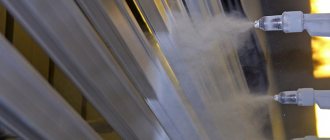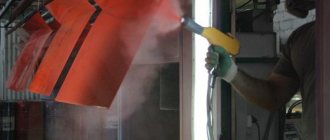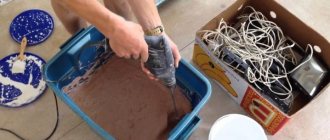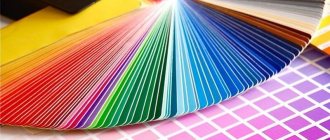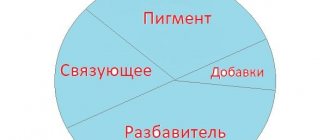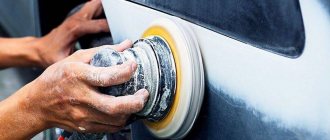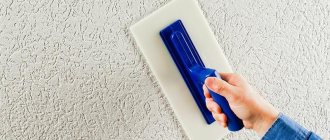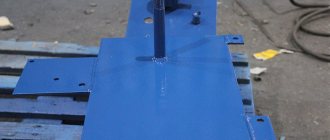Do-it-yourself powder painting requires special equipment, which you can purchase or partially make yourself. Regardless of the decision made, this is a rather labor-intensive and costly process. But this option for applying paint is one of the most effective, since the resulting coating is durable and durable.
Advantages of polymer paint
The polymerization oven is a heating device for working with powder paint. The coloring layer is applied by melting. At a certain temperature, powder paint begins to melt. The polymerization temperature is 100 degrees and above. It forms a viscous film that wets the surface of the substrate.
The duration of the process ensures that the coloring matter penetrates into all remote places and fills in uneven areas. The coating has maximum adhesion. This effect is difficult to achieve when painting using conventional methods. The advantages of powder paint are obvious: harmless, economical, and reusable.
Types of furnaces
Such furnaces are classified according to a number of characteristics. They are dead-end, through, single-pass and multi-pass, vertical and horizontal. These devices can operate on hydrocarbons and electricity. The heating process occurs in several ways - convection, thermoradiation, induction. The most popular oven is a convection oven. Heating occurs due to the movement of warm air. In thermoradiation furnaces, heating occurs due to infrared radiation. The heating time of the substrate is very fast.
Necessary equipment
To make a powder coating booth, you will need to buy some equipment that cannot be made from improvised means. Working in a homemade camera will require strict adherence to precise technology. What you will need:
- A stove similar to an oven.
- Vacuum cleaner with a cyclonic nozzle.
- Spray gun.
- Availability of ventilation.
- Strong compressor for supplying compressed air.
- Reliable, powerful source of electricity.
- Filter with pressure regulator.
You can use a regular model of a spray gun. Compressed air must be blown through it under a pressure of two atmospheres. But you will often have to deal with higher pressure. It is necessary to stock up on a filter with pressure regulation. The camera device requires a powerful current source. The process will also require ventilation. You won't be able to use a simple vacuum cleaner: it will quickly clog. It is best to buy a device with a cyclone nozzle. The following equipment will be useful during the work:
- ruler,
- Bulgarian,
- level,
- welding (preferably semi-automatic),
- metal scissors,
- other tools (necessarily pliers).
The polymerization chamber can be made without welding. It can be riveted or made with self-tapping screws.
Materials and components
You will need a list of the following materials:
- galvanized sheet metal,
- profile pipe (with edge 30 mm),
- heating elements,
- cochlear fan,
- door hinges and latch,
- insulation (preferably basalt slab 100 mm),
- unit for controlling electrical appliances,
- wire with the appropriate cross-section.
It is best to light the room with sealed fluorescent lamps. They do not heat up, and the paint deposited on them will not melt. After installing the stove, the brackets are placed. They will be needed to cool the painted parts. Electrical wiring is a responsible matter. It does not tolerate errors; the circuit must be grounded. It is better to invite an experienced electrician for consultation.
Making a camera
The amount of material should be calculated by completing preliminary drawings. If you plan to process small parts, you can limit yourself to a size of 1x1x2 meters. The larger the chamber, the more energy will be required to warm it up. And this will entail serious energy costs. The frame is made of pipe and can be painted with heat-resistant paint. The sheets from which the walls will be made must fit perfectly and hermetically to the frame. The ceiling of the chamber should be equipped with brackets; the objects being processed will be attached to them.
Heating elements are placed on the sides of the walls. The devices are distributed evenly on both sides from bottom to top. Then all the heating elements are connected according to a well-thought-out electrical circuit. The heating element for the furnace is equipped with a casing for protection; the material must match the material of the walls. The casing must have holes for air, which will be supplied by a fan. The furnace fan is mounted in a device with a pair of air ducts. The intake part must be larger than the discharge part. The fan is placed so that its parts and components are outside the painting area.
The air duct is designed so that intense air flow passes through the protective covers. The air should come from below and pass through the suspended parts. The temperature will be evenly distributed throughout the entire volume of the device, which will ensure quality work. The furnace will be controlled using a control unit. He will set the parameters of the heating elements and start the fan. It will be easy for them to control the temperature in the chamber. The control cabinet must have:
- indicators and sensors for the temperature of heated air in the working chamber,
- automatic for starting the fan and heating element,
- automatic shutdown of the device in case of an accident.
Control sensors are mounted so that one is on top, the other is on bottom. They should be equally distant from the heating elements. It is advisable to buy a factory unit that will control the processes in the chamber. The device will be more functional. A thermostat with automatic control will set a more precise operating mode.
Making a furnace
The manufacture of a powder paint polymerization oven should begin with calculations and a clear understanding of what will be painted in this oven. Dimensions are very important, since the larger the oven, the more energy will be required to warm it up, and the more time it will take to reach the optimal temperature.
On the other hand, the chamber must contain all the products to be painted in such a way that they do not come into contact with each other.
Advice! It is not practical to make a chamber for one-time painting; it will be much easier to order this work from specialists.
For example, today, cars are often painted with powder paints, and therefore the chamber must accommodate the entire car, and at the same time, there must be a margin of at least 30-50 centimeters on each side.
If you have decided on this question, then the next step is to compile a list of everything you will need:
- Profile pipe, no less than 40 by 20 mm, to create a frame.
- Basalt wool, 50 mm thick.
- Galvanized steel sheets.
- Double-action fan with ducts for air circulation inside the chamber, distributing temperature throughout the entire volume.
- Heating elements are designed so that the temperature in the chamber rises to 200 degrees. For accurate calculations of the number of heating elements, it is better to contact specialists.
- Control unit with thermostat and thermostat.
- Two thermocouples for measuring temperature at the bottom and top of the chamber.
Required Equipment
In order for the process of self-painting to be practically no different from the factory one, it is necessary to choose a suitable place where the work will be carried out.
When the premises have been found, you need to collect and prepare the necessary equipment:
- oven for polymerization (drying);
- constant voltage source (about 25 kV);
- powder paint sprayer (gun);
- LMB.
Accuracy and a little experience will not hurt in the work. But if it’s not there, it doesn’t matter; by following the instructions, you can avoid most mistakes and get quite a decent result.
Making a furnace
Polymerization is an important step in the hardening of powder paint. If this item of work is omitted, the paintwork will not adhere to metal surfaces. Therefore, equipment such as a furnace - also called a polymerization chamber - is necessary first of all. This thing is expensive, so you can make it yourself, from scrap materials. We will need (the polymerization chamber will have dimensions of 2x1x1 m):
- profile pipe;
- non-flammable thermal insulation (basalt slab);
- sheet metal (can be ordered by size);
- tangential fan;
- Heating elements.
The oven assembly instructions consist of the following steps:
- Weld a frame from the profile.
- Put insulation in it.
- Cover the walls with sheet metal. Finish the outside with gypsum fiber.
- For convection in the chamber, install a tangential fan, welding it with a narrow outlet and a wide inlet.
- Insert the fan into the chamber. It will take in air at the top, drive it through the heating elements, expel it at the bottom, and then distribute it throughout the entire volume of the chamber.
- Install the heating elements along parallel walls and connect them according to phase distribution.
- Close the heating elements, leaving the fan open, the main part of which should be located outside the chamber (so as not to melt the winding).
- Install an electrical panel. True, it is better to entrust this work to a specialist.
The resulting equipment - a polymerization chamber - will have a power of 12 kW when warming up and 6 kW in operation.
Important! The energy source in such powder paint drying ovens can be not only electricity, but also natural gas and diesel fuel.
Painting tool - gun
To apply powder paint to a product, a special device is required. This is an electrostatic spray gun or a tribostatic powder spray gun. But buying expensive equipment for rare use is not advisable. Since in our case everything is made by hand at home, such a device can be made in about 10 minutes. Such a gun is easy to use, cheap and practical. The transition from one paint to another takes a few seconds.
Design and equipment of a gun for powder painting
How to make a powder paint gun:
- Take a regular plastic 1.5 liter bottle. The main thing is that it is dry and clean.
- Fill it 1/3 with powder paint, screw it with a metal plug.
- Make small holes in the cork. The more holes, the better the application. Clean the outside of the plug from any burrs left after piercing.
- Connect the positive wire from the high-voltage source to the plug.
For this purpose, you need a converter that can deliver 25,000 volts DC. These are used in stun guns, lighters for gas stoves, boilers and speakers. They can be powered by batteries or accumulators, converting 3-6 volts into the required 25 kV.
Use caution when working with high voltage. It is best to have the converter assembled by a qualified electrician.
After all the manipulations, you get a pretty decent pistol.
Little things you can't do without
Before starting painting, you need to carefully ensure that all operations take place under ideal conditions:
- Excellent lighting is essential. Use fluorescent lamps. Powder paint adheres perfectly to a regular lamp.
- You need good ventilation with two motors (inlet and outlet). Additionally, you will have to wear a gauze bandage, or better yet, a professional respirator.
- We will have to invent a way to collect the remaining powder paint. In the initial stages, use an old powerful vacuum cleaner.
When everything is carefully prepared, you can start painting the necessary parts yourself.
How to create a chamber for powder painting and polymerization with your own hands
First and foremost: the dimensions of future painted products. The paint shop has dimensions that most likely cannot be adjusted after assembly. Therefore, consider whether you will be painting furniture or monumental metal structures.
Keep in mind that you will still have to buy some elements, because it is impossible to make them yourself. This is a recovery system, a spray gun for powder painting, heating elements for a baking oven, a vibrating table, and heaters.
Assembly of chambers for polymerization and painting
Start by building the wireframes. They can be made from pipes or metal slats and there will be two of them. One, slightly smaller, is inserted into the other so that there is 10-15 cm between them. Stuff basalt fiber into this space. No other fiber is suitable for a baking oven - it will not withstand the temperature or will be too expensive.
And you can put any sealed fiber into the frames of the powder coating chamber, made by yourself. Make a rectangular hole in each chamber no wider than 20 cm. In the oven it will be an air duct, and in the paint booth a filter will be inserted here - a powder catcher.
Heating elements in the baking chamber
Without electrician skills, it is better not to install heating elements. Basalt wool is non-flammable, but a short circuit can easily be caused by improper electrical connections and grounding. At best, the polymerization chamber will not work.
Technology
The process of painting metal parts with powder compositions can be divided into three stages. These are surface preparation, direct painting (spraying) and consolidation of the result (polymerization).
Preparatory stage
He's the most important. The result of the work depends on how well the surface is prepared for painting. Follow these instructions:
- Take a regular clean cloth and clean the entire surface of the workpiece from dust and dirt.
- Use sandpaper or specialized metal brushes to clean areas with corrosion.
- Degrease the part with a solvent, this will increase the adhesion of the surface to the paint.
- Perform priming. To do this, coat the product with paint based on inorganic substances. Thanks to this layer, the risk of air and moisture penetration under the dried paint is eliminated.
- Apply a layer of sodium compounds and chromium nitrate on top of the part. This process is called passivation. It is carried out so that rust does not appear during the preparation of the part for painting. All the steps are quite simple, so everything can be done at home with your own hands.
- Dry the workpiece in a homemade oven.
How to paint with powder paint
After all the equipment has been assembled, purchased and adjusted, you can paint the metal parts yourself.
Paint selection
Powder paints are divided into two categories:
- Thermoplastic. The principle of obtaining the coating is that the powder is applied to the part that is being baked. The created layer is only affected by temperature. This group includes compositions based on polyvinyl butyral, polymers, polyamide, and polyefin.
- Thermosetting. The essence of the process is that fusion is accompanied by a certain chemical reaction. This allows you to obtain a surface that is resistant to any impact. Options for such mixtures: epoxy, polyester, epoxy-polyester, polyurethane.
Please note that the color of the selected paint is not tinted.
Both thermoplastic and thermoset compounds come in a wide range of colors
Dyeing technology
Housework requires the creation of certain conditions. All processes are distributed across areas to prevent disruption of the painting technology due to dust and dirt.
Procedure:
- Metal processing is carried out. The surface is thoroughly cleaned of the old layer. If traces of blackening or bluing are observed, the coating must be completely removed.
If the part has an old coating, it must be removed - Cleaned parts are degreased and thoroughly dried. If required, phosphating is carried out. Areas that do not need to be painted are covered.
- The processed product is placed in the spray booth and grounded. To do this, it is hung on hangers. Hooks should not interfere with the uniform distribution of the composition.
- Using a gun, powder is sprayed onto the surface of the part. Care must be taken as the composition can be easily rubbed off when touched. If this happens, a new coat will need to be applied. For this, the best solution would be to have a mobile attachment.
Powder coating - After processing, the product is placed in the oven. The required temperature regime is selected, the heating process lasts from 10 to 30 minutes. To paint the product correctly, you need to observe the temperature for each layer: if a primer is applied, then it is about 150–160°C, for a base coat – 170–180 degrees, and for a base coat – more than 190°C. Naturally, the indicators depend on the material and size of the part.
- After baking, the product is removed from the oven. For complete adhesion of the paint, it is recommended to wait a day.
The baking temperature of the coating depends on the type of composition, but in any case it should not be higher than 200ºС
Naturally, to obtain the optimal result, it will take some time to correctly configure all the equipment and develop a clear sequence of the technological process. But if all conditions are met, the result will exceed all expectations.
Principle of operation
At the beginning of the entire process, preliminary cleaning and degreasing of the parts to be painted are carried out. To mechanically remove roughness from a product, shot blasting and sandblasting units are used.
Detergents with an acidic or alkaline environment, as well as organic solvents such as white spirit, acetone or other compounds, are used as degreasers. A large number of parts are degreased in special containers at a temperature of 40 - 60 degrees Celsius with solutions of special detergents.
A layer of powder paint is applied to the part or product to be painted; this is done in different ways, depending on the type of polymerization installation. Next, the product to be painted is moved into an oven, in which the polymer powder is heated and melted on the surface of the product being processed.
Due to high adhesiveness, the polymer fills all microscopic roughness on the surface of the workpiece and adheres tightly to it. Next, sintering occurs, which makes its structure strong and uniform, and even greater adhesion of the powder paint to the surface of the product being painted occurs.
Advantages of using a coloring installation
Thermal dyeing technology helps solve a number of problems:
- KM losses are reduced to 2%, with the conventional method up to 50%.
- The CM powder, which remains in excess on the surface and hangs in the air, is collected by filters and reused in the production process. For this purpose, the chamber is equipped with a recovery system.
- The paint in powder form is additionally filtered from contaminants.
- The thickness of the coating layer is adjustable in the range of 40-250 microns.
- The protective and decorative layer lasts up to 20 years.
- Since the interaction between paint and base occurs at the molecular level, the painted part resists mechanical stress and the surface cannot rust. Water does not penetrate through the paint layer. Liquid compositions create a smooth coating on the surface with a special shine, which is comparable to polished surfaces.
- After the chamber, the painted parts are not subjected to additional drying.
Important: powder painting in the chamber does not allow for tinting.
A big disadvantage of using a furnace is its low payback when painting a small number of parts. Powder CM is an expensive material.
Advantages and disadvantages
When painting with a polymer powder, interaction occurs at the molecular level with the surface being painted, so this method of applying paint has a number of advantages, the main ones being:
- High resistance of the painted product to mechanical influences, such as impacts, cracks, bends, chips.
- There is no corrosion on the painted product, such a coating does not allow water to pass through, and the part itself is not subject to rust.
- Surfaces painted in this way have a shiny and smooth appearance. When using liquid paints, this effect can only be achieved after additional polishing of the product.
- The applied polymer coating will last for many years, since microscopic particles of paint, when heated, are introduced into the metal structure at the molecular level.
- This type of painting method is highly environmentally friendly, the consumption of painting material is low, and the amount of waste and its release into the environment is minimized.
But there are a number of disadvantages associated with this method of coating; they are of an economic nature:
- The coating process is complex, requiring proper operator classification and a long time for each operation.
- Working with powder paints requires auxiliary equipment, such as a spray gun or oven electronics. If the polymer chamber itself can be made independently, then they will still have to be purchased additionally.
- The high cost of powder-type polymer paint and its inaccessibility.
- Large final price for the finished product painted in this way.
The entire variety of ovens for painting using polymerization can be divided into several main groups according to different criteria:
- Based on the degree of mechanization of the process, continuous and dead-end furnaces are distinguished. In continuous furnaces, the workpiece is placed in one technological inlet, and the finished product exits through another. In dead-end furnaces, unloading and loading of products is carried out through the same opening.
- According to the energy consumed for the operation of furnaces, electric installations and furnaces operating on hydrocarbon fuel (solar, fuel oil, natural gas) are divided.
- According to the degree of heating, all furnaces for the polymerization of powder paint are divided into induction, thermoradiation and convective. The most common option is convective, when the workpiece is heated due to the movement of heated air flows.
- According to the orientation of the working chambers in space, furnaces of horizontal and vertical types are divided.
Subspecies and their features
Nowadays many subtypes of such cameras are produced, and the range is only expanding. The structural components are:
- Dead end.
- Checkpoint.
- Two-post.
- Single post.
- With cartridge filter.
Let's look at the characteristics of some of them.
Single post:
- It has a recuperator equipped with a single filter.
- Can handle up to 99% of airborne paint spray.
- The filter is cleaned as follows: blown manually or using automatic mode.
- Power not less than 3 kW.
- Working space (standard): 1700 x 1100 x 2000 mm.
- Weight – 390 kg.
Two-post (marking KO2):
- Pass-through type.
- It has two recuperators and two replaceable filters.
- The technology for re-cleaning the paint has been developed (up to 99% of the sprayed composition is returned to work).
- Filters can only be cleaned with pressurized air.
- Power from 5 kW.
- Working space 1700 x 1100 x 4000 mm.
- Weight – 640 kg.
This type is most convenient when processing parts from several sides. The products pass through openings for spraying on both sides. This is convenient when two system operators are working at once.
With a cartridge filter, the powder coating booth is equipped with:
- Paint booth.
- Replaceable filter system.
- Filter cartridges.
- Sieve with vibrating mechanism.
- A container for selecting paint with filters.
- Powder injector.
- With a scraper.
- Compressed air filter blowing system.
- An absolute filter.
- System for supplying clean air.
- Lattice.
There are also special working moments specifically for this type. They are as follows: due to draft, air with powder paint is supplied. All this goes through the cartridges. The paint is sifted and poured into the receiver. Then this composition is fed into a powder coating gun. All excess that remains on the filter is removed with compressed air. And if there is a lack of paint in the system, the sensor lights up.
Most often they buy and use walk-through models of powder chambers, because they are part of a painting line integrated into a common transport system.
How to choose?
You should choose a furnace for producing painted surfaces using the polymerization method based on the type of fuel on which it will be operated, the expected power and the number of parts to be painted per unit of time.
In order to accurately comply with technological conditions, it is necessary to carefully read the technical documentation for the product, what temperature and time the furnace can produce, how fast or slow this or that stage of processing of workpieces occurs.
Financial capabilities should also be taken into account, as well as the projected payback period for new equipment. Equipment and devices for such painting are not cheap, as are the raw materials (polymer dry paints).
Manufacturers
The main Russian manufacturers of such installations and powder paint are:
- Production;
- ;
- (production of powder paints, Podolsk);
- ;
- NPP "Raduga";
- LLC "Non-standard equipment plant" (Stary Oskol);
- LLC Ufa Process Equipment Plant.
Among the foreign manufacturers of furnaces for the polymerization of powder paint, we can note the products of companies from Ukraine, Turkey, Bulgaria, Kazakhstan, Poland, Belarus, and Romania.
Models
- Rainbow-32. This is a powerful conveyor unit, the dimensions of the processed products are 1000x700x60 mm, with one-shift operation the line is capable of painting 30,000 parts per month. The price for polymerization ovens of this brand is 1.35 million rubles.
- Rainbow-30. An even more powerful conveyor unit, from 36 to 100 kW. Its overall dimensions are 3600x2400x2500 mm. The cost of such a unit is 4.7 million rubles.
- Oven for powder painting KP-150. It is intended for coating car rims. Accommodates up to 8 disks with a diameter of 16 inches in 1 working cycle, or 4 disks up to 24 inches in size. Its price is 130,000 rubles.
- Oven for powder painting KPM. A universal device that finds application in many areas of metalworking. It can be used to paint sections of fences, as well as bicycle frames, tanks, benches, heating radiators, etc. The maximum weight of loaded products is 500 kg. Its cost is 232,000 rubles.
- MAX-PT-3200. The internal size of the furnace is 1500x3200x1800 mm, the maximum dimensions of products that can be processed in it are 1.4x3.1x 1.6 meters. Its price is from 310,000 rubles.
- MAX-PT-2500-1. The internal size of the furnace is 1400x2500x1800 mm, the maximum dimensions of products that can be processed in it are 1.3x2.4x1.6 meters. Its price is from 270,000 rubles.
- KP-450. It is intended for painting electrical cabinets, fencing elements, sheets and other metal products. It has small dimensions and is well suited for tight production spaces. The cost of such a unit is 317,000 rubles.
- KP-040. Oven with small dimensions for painting small parts, operating temperature up to 160 degrees Celsius. Its cost is 67,000 rubles.
- KP-230. An analogue of the KP-150 furnace, but with increased overall dimensions, it is capable of processing parts with dimensions up to 1.1 - 1.5 meters. Its cost is 156,500 rubles.
- Aktek polymerization oven 3500x1500x2000. The installation has large dimensions and is available in both dead-end and through-hole versions. Its price is from 350,000 rubles.
DIY making
It is quite simple to make a powder paint polymerization oven with your own hands.
Materials and tools
To make such a device yourself you will need:
- Building level;
- Welding machine;
- Angle grinder (grinder);
- Metal scissors;
- Roulette;
- Metallic profile;
- Sheets of steel;
- Electrical cable;
- Fan;
- Electric heating elements;
- Temperature control unit;
- Insulation;
- Hinges and latch for loading hatch.
Assembly of the structure
A do-it-yourself polymerization chamber for powder coating is made in the following way:
- The main frame is welded from profile pipes.
- Then it is insulated with mineral wool.
- The frame provides space for a loading hole, and the hinges of the future door are welded.
- The frame is covered with metal sheets.
- Heating elements, thermocouples are attached inside (or on the side) and an electrical cable is pulled through.
- The wires are connected to the temperature control and regulation unit, and it is connected to a 220 or 380 volt network.
- The electrics inside the heating chamber are closed using sheet steel.
- Two holes are made in the housing and a fan is connected, which should be located outside the installation.
- A test run of the stove is being carried out.
- The key to successful application of a polymer coating will be strict adherence to all stages of painting. First, you need to thoroughly degrease the workpiece. Then you should evenly apply the powder to the part using special devices.
- Next, you need to withstand all temperature conditions, until the painted parts cool completely. And do not forget about the safety rules when working with electric ovens, use special clothing, face and hand protection.
Required tools and materials
We will tell you how you can make this unit with your own hands. To do this, you must follow the instructions specified in the article. Making the device will not be too difficult; you can make a stove without the help of a welding tool. Use screws and rivets instead. Your skill plays a decisive role here.
Necessary tools for making a stove with your own hands:
- level;
- welding tool;
- pliers;
- Bulgarian;
- metal scissors;
- roulette.
We need to determine how much of each material we will need; for this we can make drawings. We will count on them.
We will need the following materials:
- sheet metal;
- insulation;
- profile pipe;
- heating elements;
- hinges and latches for the door;
- cable;
- cochlear fan;
- temperature control unit.
When calculating the required oven volume, remember that an oven that is too large will be difficult to heat .
